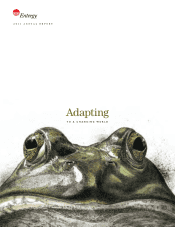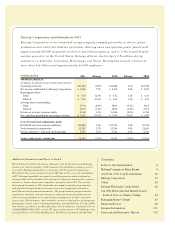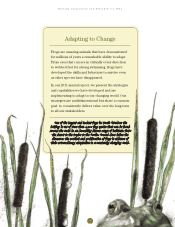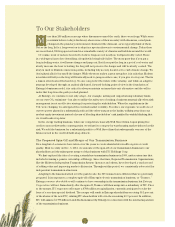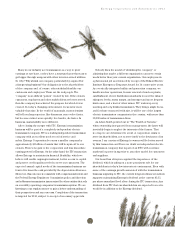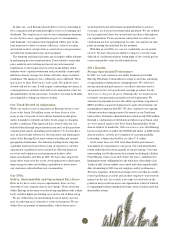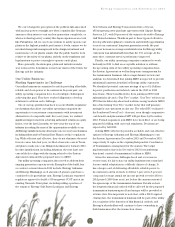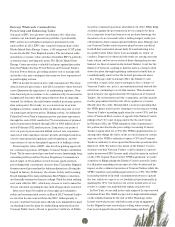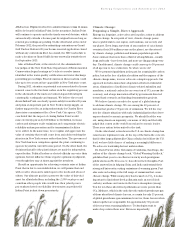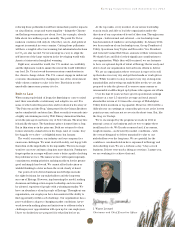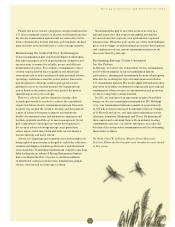Entergy 2011 Annual Report Download - page 9
Download and view the complete annual report
Please find page 9 of the 2011 Entergy annual report below. You can navigate through the pages in the report by either clicking on the pages listed below, or by using the keyword search tool below to find specific information within the annual report.
ASLB action. Pilgrim involved two admitted issues versus 14 issues
still to be heard for Indian Point. In the meantime, Indian Point
will continue to operate under the timely renewal doctrine, which
automatically extends a license past its original term so long as
renewal proceedings are pending. On the other hand, at the end of
February 2012, the period for submitting contentions on Grand
Gulf Nuclear Station’s 20-year license renewal application closed
without any contentions filed. As a result, the NRC’s schedule to
make a decision on Grand Gulf’s license renewal is tentatively set
for September 2013.
Also at Indian Point, at the state level, the administrative
law judges of the New York State Department of Environmental
Conservation began hearings in October to resolve issues
identified in the water quality certification and water discharge
permitting proceedings. Final decisions on these matters could
take up to two years and are appealable in New York state court.
During 2011, attention on potential outcomes related to license
renewal came to the forefront earlier on in the regulatory process
in the aftermath of the nuclear events in Japan following its
catastrophic earthquake and tsunami. We believe the record
shows Indian Point can clearly operate safely for another 20 years
and plays an important part in New York’s energy supply, as
further supported by an independent study by Charles River
Associates commissioned by a New York City agency. CRA
concluded that the impact of closing Indian Point would
raise electricity prices by $10 billion to $12 billion, increase
carbon and nitrogen oxide emissions and compromise electric
reliability unless generation and/or transmission facilities
were added. At the same time, we recognize and appreciate the
value of certainty that would come from amicably resolving the
situation in New York sooner rather than later. The governor of
New York has been outspoken against the plant continuing to
operate beyond its current license period. On the other hand, the
decisions that affect the plant’s future are made by independent,
expert bodies. Political leaders or elected officials can voice their
opinions, but not influence those experts’ opinions or judgment,
even though they may at times appoint the members.
Should an opportunity for achieving certainty arise at Indian
Point that is fair to our stakeholders, we will pursue that end
with creative ideas and a mind open to the needs and ideas of
others. Our ultimate goal is to preserve the value of this vital
asset for all stakeholders, including the 1,200 employees and
countless other people who would lose their jobs if power
prices skyrocketed or reliability deteriorates as predicted if
Indian Point is shut down prematurely.
Climate Change:
Proposing a Simple, Direct Approach
Entergy is a long-time, active advocate for policy action to address
climate change. In our point of view, climate change poses
unacceptable risk to our region, our business, our society and
our planet. Even frogs, survivors of any number of cataclysmic
events in their 200 million years on the planet, are threatened
by climate change, pollution and human population growth.
Some estimate that more than a third of all amphibians – mostly
frogs and toads – have been lost, and more are disappearing every
day. Unaddressed, climate change could cause up to 50 percent
of all species to face extinction. So what can we do?
We’ve presented guidelines in the past for a sustainable carbon
policy, but in the face of political realities and the urgency of the
climate change issue, we now advocate a simpler approach. Our
approach includes immediate adaptation efforts in vulnerable
areas, elimination of inefficient climate-related subsidies and
mandates, a national carbon fee on every ton of CO2 across the
economy, and a large innovation effort by government directed
toward basic research and funding demonstration projects.
We believe America needs to be a part of a global strategy
to address climate change. We are among the 10 percent of
nations that produce 90 percent of emissions. We led the way
into the climate situation with early industrialization that drove
unprecedented economic prosperity. We should lead the way
out, using American ingenuity, our sense of duty and the bully
pulpit that comes as the world’s moral and economic leader.
There is no nation better suited to the task.
On the other hand, action here in the U.S. on climate change has
raised some legitimate fears. At the top of the list is the concern
that if other large polluters like China or India don’t follow the U.S.
lead, we have little chance of making a meaningful difference.
We advocate leadership but not unilateralism.
Dr. David Victor of the University of California, San Diego, the
author of the climate change book, “Global Warming Gridlock,”
published last year to excellent reviews by such prestigious
publications as The Economist, has offered new thoughts. Part
of the answer lies in helping China and India understand their
strong self-interest in cutting emissions of warming gases. Part
also rests on looking at the full range of emissions that cause
climate change. While most policy has focused on CO2, it is also
important to limit short-lived pollutants such as soot (black
carbon), methane and ozone in the lower atmosphere (smog).
Ton for ton these short-lived pollutants are more potent than
CO2. Methane, which is the only directly emitted greenhouse gas
of these short-lived climate forcers, accounts for only 15 percent
of global greenhouse gas emissions; however, these forcers when
taken together are responsible for approximately 50 percent
of the near-term warming influence. Technologies exist to
make deep cuts in these now. But more importantly,
Entergy Corporation and Subsidiaries 2011
7

